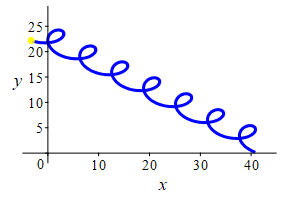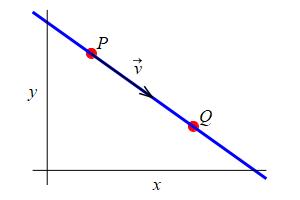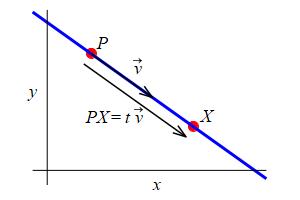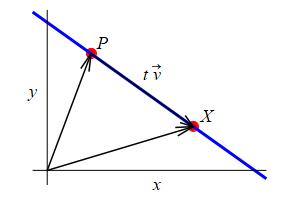5. Vectors
e. Parametric Curves
A curve (also called a planar curve) may be specified in one of three ways:
- as the graph of a function of \(1\) variable: \(y=f(x)\).
- as the graph of an equation in \(2\) variables: \(F(x,y)=0\).
- as a parametric curve: \(\vec r(t)=\left\langle x(t),y(t)\right\rangle\).
Graphs of functions and equations were discussed previously in the chapter on Functions. Parametric curves are introduced here. They will be discussed in much more detail in the full chapter on Parametric Curves.
To begin, the formula, \(\vec r(t)=\left\langle x(t),y(t)\right\rangle\), gives the \(x\) and \(y\) coordinates of a point as a function of a parameter, \(t\), which is usually interpreted as time. (The arrow over the \(\vec r\) and the angle brackets indicate that this is a vector which is actually the position vector pointing from the origin to a point on the curve. )
We begin with the parametric form of a line and then return to discuss more general curves.

1. Parametric Lines
We usually think of a line as the graph of a function such as \(y=3x+6\) which is given in slope-intercept form, \(y=mx+b\) where \(m=3\) is the slope and \(b=6\) is the \(y\)-intercept. But this will not work for a vertical line because the slope is infinite, i.e. undefined. More generally, we can think of a line as the graph of an equation such as \(2x+5y=7\) which is given in standard form, \(Ax+By=C\). This will in fact work for any line. However, we are interested in having a formula which gives a point on the line as a function of time. So we go back to first principles:
A line may be characterized by specifying
- two points \(P\) and \(Q\) on the line, or
- a point \(P\) on the line and a non-zero vector \(\vec v\) which lies in (is parallel to, or is tangent to) the line, called a direction vector or a tangent vector for the line.
Note that in this context, a direction vector may or may not be a unit vector. It is not the same as the direction of a vector.

If we are given two points \(P\) and \(Q\), then we can construct a tangent vector as \[ \vec v=\overrightarrow{PQ}=Q-P \] So in the following, we will assume we have a point \(P\) and a direction vector \(\vec v\).
Find a parametric equation for the straight line passing through the point \(P\) which is parallel to the direction vector \(\vec v\).
We are trying to find a formula for the general point \(X\) on this line in terms of \(P\) and \(\vec v\). Notice that the vector \(\overrightarrow{PX}=X-P\) is parallel to the vector \(\vec v\). This means that the vector \(\overrightarrow{PX}\) is a scalar multiple of \(\vec v\). Thus, there exists a scalar \(t\) such that: \[ \overrightarrow{PX}=X-P=t\,\vec v \] If we solve this equation for the vector \(X\), we get:

The parametric equation of the line through \(P\) in the direction of \(\vec v\) is: \[ X=P+t\,\vec v \qquad (1) \] The number \(t\) is called the parameter which tells where the point \(X\) is located on the line.
Thus, every point \(X\) on this line can be written as the initial point \(P\) plus a scalar multiple of the direction \(\vec v\). This addition means that we put the tail of the vector \(t\,\vec v\) at \(P\) and then the point \(X\) is the tip of \(t\,\vec v\). The tip-to-tail addition becomes clearer if we regard \(P\) and \(X\) as position vectors as in the plot.

If we let \(X=(x_1,x_2)\), \(P=(p_1,p_2)\) and \(\vec v=\langle v_1,v_2\rangle\), then equation (1) can be rewritten as any of the following: \[\begin{aligned} (x_1,x_2)&=(p_1,p_2)+t\langle v_1,v_2\rangle=(p_1+v_1t,p_2+v_2t)&&\text{(2)} \\ \vec r(t)&=\langle p_1+v_1t,p_2+v_2t\rangle&&\text{(3)} \\ x_1(t)&=p_1+v_1t \qquad x_2(t)=p_2+v_2t&&\text{(4)} \end{aligned}\] If we want to avoid subscripts, we write \(X=(x,y)\), \(P=(p,q)\) and \(\vec v=\langle u,v\rangle\). Then equation (1) can be rewritten as any of the following: \[\begin{aligned} (x,y)&=(p,q)+t\langle u,v\rangle=(p+ut,q+vt)&&\text{(5)} \\ \vec r(t)&=\langle p+ut,q+vt\rangle&&\text{(6)} \\ x(t)&=p+ut \qquad y(t)=q+vt&&\text{(7)} \end{aligned}\] Any of the equations (1) - (7) can be called a parametric equation for the straight line and \(t\) is called the parameter. Equations (1), (2), (3), (5) and (6) are in vector form while equations (4) and (7) are in scalar form. Equation (1) is in abstract form while the rest are in component form.
Frequently, the parameter \(t\) is interpreted as time. In that case, the parametric equation of the line can be interpreted as the position, \(\vec r(t)\), of a particle which at time \(t=0\) is at the point \(P\) and has constant velocity \(\vec v\), so that at time \(t\), its position is the point: \[ \vec r(t)=P+t\,\vec v \]
Find a parametric equation for the straight line passing through the points \(P=(2,-3)\) and \(Q=(-5,7)\).
To find a parametric equation for this line we need to find a vector which is parallel to the line. This is: \[ \vec v=\overrightarrow{PQ}=Q-P=(-5,7)-(2,-3)=(-7,10) \] Our equation is: \[ X=P+t\,\vec v \] or: \[ (x,y)=(2,-3)+t\,(-7,10)=(2-7t,-3+10t) \] or: \[ x=2-7t \qquad \text{and} \qquad y=-3+10t \]
Find a parametric equation of the line passing through the point \(P=(2,-4)\) which is parallel to the line \((x,y)=(4-t,3+2t)\).
\((x,y)=(2-t,-4+2t)\)
The line \((x,y)=(4-t,3+2t)\) can be written as: \[ (x,y)=(4,3)+t(-1,2) \] So its direction vector is \(\vec v=(-1,2)\). The line we want has the same direction. So its equation is \[\begin{aligned} (x,y)&=P+t\vec v =(2,-4)+t(-1,2) \\ &=(2-t,-4+2t). \end{aligned}\]
You can practice finding the parametric equation of a line in \(\mathbb{R}^2\) using the following Maplet (requires Maple on the computer where this is executed):
Parametric Equations of a Line Through 2 Points in 2D Rate It
Heading
Placeholder text: Lorem ipsum Lorem ipsum Lorem ipsum Lorem ipsum Lorem ipsum Lorem ipsum Lorem ipsum Lorem ipsum Lorem ipsum Lorem ipsum Lorem ipsum Lorem ipsum Lorem ipsum Lorem ipsum Lorem ipsum Lorem ipsum Lorem ipsum Lorem ipsum Lorem ipsum Lorem ipsum Lorem ipsum Lorem ipsum Lorem ipsum Lorem ipsum Lorem ipsum